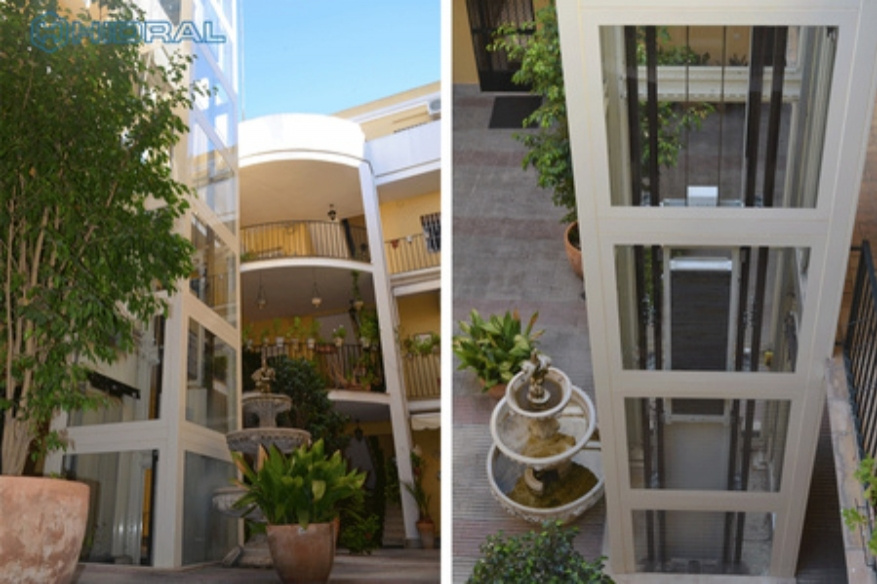- Quem Somos
- Produtos
- Acesso a Clientes
- Notícias
- Contato
- Ecommerce
- Marketing e Vendas:
+34 954 514 500
sales@hidral.com
This website uses its own and third-party cookies to improve our services and collect information about your browsing. If you click "accept" or continue browsing, we will consider that you accept the use and installation of your device or device. You will find more information in our Política de cookies.
26/06/24

Residential lifts have deeply transformed the experience of living in residential buildings, offering more than just comfort and accessibility. Since their invention, these devices have evolved significantly and have improved the daily lives of millions of people around the world.
Lifts as a concept can be traced back to ancient Rome. We credit Archimedes with the construction of the first prototype, where rudimentary mechanisms were used to lift heavy objects. However, it was in the 19th century that residential lifts were first installed in buildings, revolutionising the way people lived and worked in cities. The technology behind these early lifts was basic by modern standards, but laid the groundwork for future innovations.
During the 20th century, advances in engineering allowed the expansion of the use of high-rise residential lifts, especially in urban areas with high population density. This facilitated vertical construction, improved the efficiency of the use of urban space and reduced the need for horizontal expansion, promoting urban sustainability.
The benefits of residential lifts are clear in many respects. First of all, they provide universal accessibility, allowing people of all ages and abilities to move freely around buildings. This is especially crucial in tall buildings, where climbing stairs may be physically demanding or impossible for some residents.
In addition, lifts suitable for emergencies improve safety in hazardous situations and can be instrumental in saving lives and facilitating evacuation in the event of fire or other adverse events.
Modern technology has taken residential lifts to new levels of efficiency and comfort. Advanced control systems optimise vertical movement and improve the user experience by minimising waiting times and energy consumption. Furthermore, the materials used in the construction of modern lifts are safer and more durable, ensuring reliable operation over time.
Today's lifts are equipped with intelligent technology that allows real-time performance monitoring and efficient preventive maintenance. This reduces downtime and extends the life of the equipment, providing residents with greater peace of mind and reliability in their daily use.
The presence of residential lifts directly translates into a better quality of life for residents. First of all, they facilitate access to housing for the elderly and people with reduced mobility, allowing them to maintain their independence and actively participate in community life. This encourages an inclusive and supportive environment within the buildings.
In addition, lifts remove architectural barriers, which promotes social integration and community cohesion. Neighbours can interact more fluidly and share resources more efficiently, strengthening a sense of community and belonging.
The psychological benefits are also significant, as residents feel safer and more comfortable in an environment where accessibility is a priority. This can contribute to better mental and emotional health, especially in older people, who may experience mobility-related anxiety.
Innovation in the design of residential lifts continues to advance, with an increasing focus on energy efficiency and sustainability. Lifts powered by renewable energies, such as solar energy or regenerative braking, are gaining popularity due to their lower environmental impact and reduced long-term operating costs.
Moreover, the integration of digital technologies is transforming the user experience, with systems that allow remote programming, real-time monitoring and automatic response to maintenance needs. These innovations not only improve the operational efficiency of buildings, but also raise the standard of comfort and safety for residents.
When it comes to choosing a residential lift provider, quality, reliability and service are paramount. Hidral stands out as a leader in the sector, offering customised solutions that are tailored to the specific needs of each building. With decades of experience and a firm commitment to innovation, Hidral guarantees the installation of lifts that meet the highest standards of safety and efficiency and significantly improve the quality of life of its users.
Hidral cares about the functionality and safety of its products. Each Hidral residential lift facility is backed by a team of trained professionals who ensure that the process is as smooth and satisfying as possible for everyone involved.